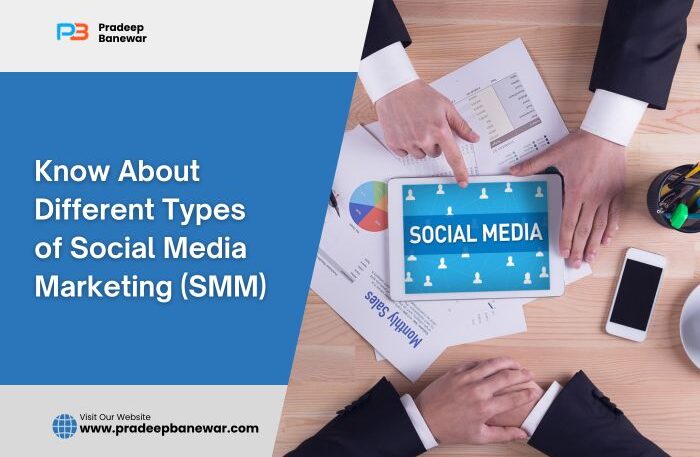Social media marketing is now essential for organizations and companies looking to succeed online in the current digital era.
Social media provides an unmatched opportunity to interact with several audiences, create brand loyalty, and increase income thanks to its billions of active users across numerous platforms.
However, staying on top of the various social media platforms and marketing techniques can be difficult.
Understanding the many forms of social media marketing and how they might cooperate to further your objectives is crucial for navigating this dynamic environment successfully.
You may use this blog post, titled “Types of Social Media Marketing: Know What You Need to be Successful,” as a thorough reference to help you understand the social media marketing benefits and industry.
From the fundamental concepts of knowing your audience to in-depth analyses of various social media marketing tactics, we’ll cover the many sides of this digital profession.
This guide will give you the information and tools required to make informed decisions and produce significant results, whether you’re an experienced marketer trying to improve your strategy or a business owner eager to start your social media adventure.
Let’s discuss social media marketing’s complexities so that you can maximize its potential and grow your online presence.
Understanding Your Audience
Understanding your target audience is the key to developing a successful social media marketing strategy.
First and foremost, demographics are crucial.
Essential considerations in personalizing your content include age, gender, geography, and financial level.
For instance, content geared toward teenagers and middle-aged professionals will differ substantially.
Accurately identifying these demographics benefits from thorough audience research.
Additionally, psychographics explore your audience’s thinking and lifestyle.
Create content that appeals to your audience’s preferences and meets their wants by understanding their beliefs, interests, hobbies, and pain spots.
A higher sense of brand loyalty might result from this emotional connection.
Equally essential are behavioral insights.
Understanding your audience’s behavior on social media, including their preferred platforms, peak activity times, and preferred content formats, gives you the power to plan your posting times and content kinds for optimal impact.
Think about engagement and feedback as well.
Real-time insights into audience sentiment are available by analyzing comments, likes, shares, and direct messaging.
You can quickly change your strategy with a data-driven approach, ensuring your content remains relevant.

Types of Social Media Marketing
A wide range of methods designed to engage and interact with consumers throughout the digital environment make up the dynamic discipline of social media marketing.
For creating a comprehensive and successful online presence, it is crucial to comprehend the many forms of social media marketing.
Organic Social Media Marketing
The main objective of this tactic is to establish a sincere internet presence through unpaid labor.
It involves creating outstanding content that speaks and inspires your audience to interact with your brand.
You can engage your followers effectively by sharing educational content, responding to their comments, posting frequent updates, and creating a sense of community.
Although organic social media marketing is inexpensive, it takes time and persistent work to experience significant growth.
The main objective here is to increase audience credibility and confidence.
Paid Social Media Advertising
Paid advertising is an effective strategy for swiftly reaching a larger, more targeted audience. Instagram, Facebook, LinkedIn, and Twitter are just a few platforms that provide advanced advertising choices.
You can define the audience for your ad based on interests, demographics, and behaviors.
Due to the tremendous scalability of paid campaigns, you can change your budget and marketing plans in response to results.
This technique works well for promoting goods, services, or limited-time offers.

Influencer Marketing
Influencers are someone with a loyal following that relies on their advice.
Your brand can gain a reputation and access to a pre-qualified audience by working with influencers.
It’s crucial to pick influencers whose ideologies coincide with those of your target market and company.
Setting up specific objectives, settling on terms, and assessing the results of influencer collaborations are all necessary for effective influencer marketing.
Influencer marketing frequently centers on writing product evaluations, endorsing brands, or creating content.
Content Marketing on Social Media
Content is the cornerstone of social media marketing.
By creating engaging and informative content, you can position your company as an authority in your field.
There are many different sorts of content, including infographics, podcasts, blog posts, and videos.
The secret is to produce content that aligns with the messaging of your business and informs, inspires, or amuses your audience.
Storytelling, keeping a content calendar, and consistency in content distribution are essential elements of this strategy.
Social Media Analytics and Monitoring
Making decisions based on data is crucial for improving your social media strategy.
Understanding performance data, audience interaction, and sentiment analysis is possible thanks to various tools and platforms.
You can determine what is working and which needs adjusting by monitoring key performance indicators (KPIs) involving reach, engagement, click-through rates (CTR), and conversion rates.
Moreover, tracking social media can help you efficiently manage your brand’s reputation and respond to customer questions and complaints.
Platform-Specific Strategies
Social media marketing requires the use of platform-specific methods.
Every social media site has different features, user demographics, and content formats, so it’s critical to customize your strategy to have an impact. Here is a look at platform-specific tactics:
Facebook, the most popular social media network, serves several users.
Videos and photos with a visual component typically do well. Facebook Groups can help build communities around your company.
Facebook Ads and Sponsored Posts are just two examples of paid advertising choices that offer extremely focused reach.
- Diverse Audience: Facebook user base includes people of all ages and hobbies. Make content that appeals to an audience if you want to succeed.
- Visual Content: Infographics, pictures, and other visuals work incredibly well. Consider live streaming or producing interesting video posts because Facebook’s algorithm frequently favors video content.
- Facebook Groups: Create communities around your brand by creating and administering Facebook Groups. Within these communities, stimulating dialogue, disseminating insightful information, and attending to user issues can promote loyalty and word-of-mouth advertising.
- Paid Advertising: Numerous targeting possibilities are available in Facebook ads. It is an effective tool for businesses to market their goods or services to a targeted audience since you can target particular demographics, interests, and behaviors.
Instagram’s emphasis on images makes it the perfect platform for visually engaging content.
Use Instagram Stories and Reels to interact creatively with your audience.
The platform is quite helpful for brands that can visually display their goods or services.
Shoppable posts and influencer partnerships are common tactics.
- Visual-Centric: Visual storytelling is the core of Instagram. It should have videos, subtitles, and photographs of the highest caliber.
- Stories and Reels: Reels and Instagram Stories offer platforms for original, brief content. Use them to share user-generated content, behind-the-scenes photos, and product demonstrations.
- Shoppable Posts: Instagram’s shoppable posts feature streamlines the shopping process for e-commerce companies by enabling consumers to buy goods directly from the website.
- Influencer Partnerships: On Instagram, working with influencers who support your company can increase your following and authority.
Short and snappy content does well on Twitter because it is a real-time network.
To gain more visibility, use trending subjects and hashtags.
Quick replies and live-tweeting events will help you interact with your audience.
Twitter is a platform for disseminating news, updates, and brief knowledge.
- Real-Time Engagement: Twitter serves as a medium for interaction and real-time updates. It’s important to post frequently, respond quickly, and use popular hashtags or themes.
- Hashtags: Hashtags may improve the reach of your tweets. Look up popular hashtags in your sector and join discussions that interest you.
- Live-Tweeting: Industry conferences or events can increase brand authority and help you reach a maximum number of people.
- Visual Content: Even though text-based content is what Twitter is known for, adding photos, GIFs, and brief films to your tweets can improve their engagement.
The main focus of LinkedIn is as a professional network.
It’s the perfect forum for thought leadership and B2B marketing.
Connect with professionals, share business insights, and run targeted B2B ads on LinkedIn.
- Professional Networking: The main focus of LinkedIn is as a professional network. Share thought-provoking ideas, industry insights, and helpful articles.
- B2B Marketing: LinkedIn is a medium for B2B marketing if other businesses are your target market. To connect with decision-makers in particular industries, use LinkedIn Ads.
- Networking: To grow your network, join relevant LinkedIn Groups, connect with professionals in your sector, and participate in discussions.
- Content Publishing: LinkedIn is the perfect venue for in-depth essays and thought leadership pieces because it allows users to create long-form content.
TikTok
The popularity of TikTok’s short-form video content has grown.
To captivate a younger audience, make educational and amusing videos.
Rapidly spreading trends and problems present fantastic potential for brand exposure.
- Short-Form Video: The brevity of the videos on TikTok makes it successful. Make entertaining, engaging content that reflects the personality of your brand.
- Trends and Challenges: Watch for TikTok trends and difficulties, and join in when appropriate. It may aid in the viral spread of your content and increase its viewership.
- Authenticity: Users of TikTok respect authenticity. Share behind-the-scenes content, customer reviews, or day-in-the-life footage to humanize your brand.
Integrating Multiple Social Media Channels
Utilizing the combined strength of several platforms, integrating many social media channels is a strategic way to increase your brand’s online visibility and engagement.
Here is a closer examination of this significant feature of social media marketing:

- Consistency Across Platforms: Keep your brand’s identity and messaging consistent in every social media platform. This consistency strengthens the perception of your brand and makes it simpler for your audience to recognize and relate to you.
- Cross-Promotion: Use one platform to promote content or events on another. For instance, you can share tweets on Facebook to increase traffic to your Twitter account or use Instagram Stories to promote a YouTube video. Cross-promotion helps increase your visibility among various user bases.
- Content Repurposing: Make a content plan that enables you to reuse content across many channels. One can convert a blog post into an infographic for Pinterest, a video for YouTube, or a series of postings on LinkedIn, for instance. By doing this, you can cater to a variety of audience tastes while maximizing the value of your content.
- Multi-Channel Campaigns: Campaign coordination across several mediums can be successful. You could, for instance, advertise a contest you’re doing on Instagram, Facebook, and Twitter. This strategy generates buzz and motivates customers to interact with your business through several platforms.
- Analytics Integration: Use analytics tools to learn more about how your campaigns are doing across various platforms. You can improve your tactics, allocate resources, and determine which platforms provide the best outcomes with a data-driven strategy.
- Customer Journey Mapping: You may customize your content and engagement at multiple touch points by understanding your customer’s journey across several mediums. It can boost conversion rates and improve user experience.
- Synchronized Posting: While ensuring a consistent stream of information, scheduling articles and content releases across several channels frees up time for in-person interaction with your audience.
- Adaptation to Platform Strengths: Recognize the distinct advantages that each platform has. While Instagram excels at visual storytelling, LinkedIn might be the best platform for B2B networking. Adapt your content to take advantage of these advantages.
Measuring Success and ROI
Effective social media marketing is tracking results and return on investment (ROI).
Understanding the effects of your efforts is essential at a time when data-driven decisions are critical.
Here is a look at why and how to assess the effectiveness and ROI of your social media marketing campaigns:
- Defining Key Performance Indicators (KPIs): Clearly defining KPIs is crucial for measuring success. These have to be in line with your corporate goals. Engagement metrics (likes, shares, and comments), website traffic, conversion rates, and revenue earned are demonstrations of common KPIs.
- Tracking and Analyzing Metrics: Track and analyze your chosen KPIs using the social media analytics tools offered by platforms or third-party applications. These tools provide information on audience demographics, post-performance trends, and historical data.
- Calculating ROI: Compare the gains (such as revenue earned or cost savings) to the costs (such as advertising expenditures or content production costs) to calculate ROI. The calculation for ROI is [(Gains – Costs) / Costs] x 100. A profitable campaign will have a positive ROI.
- Attribution Models: To comprehend how multiple client touchpoints in the customer journey contribute to conversions, think about using attribution models. Multi-touch attribution more clearly illustrates each platform’s role in the conversion process.
- A/B Testing: Try various topics, publishing times, and advertising techniques. You can determine what approaches are most effective in improving your campaigns’ performance through A/B testing.
- Benchmarking: Examine your performance in comparison to industry norms and rivals. Benchmarking gives you insight and allows you to determine areas that need improvements.
- Customer Lifetime Value (CLV): Analyze the long-term worth of clients obtained through social media initiatives. Recognizing CLV might support acquisition costs and direct marketing initiatives.
- Adaptation: Utilize the data from your measurements to iteratively improve your social media approach. What is effective? Why not? To get better outcomes, modify your strategy accordingly.
- Reporting: These reports should be tailored to your target audience, whether they are executives, stakeholders, or members of your marketing team.
- Iterate and Improve: The process of calculating success and ROI is iterative. To maximize your social media marketing efforts, continuously analyze data, make data-driven improvements, and fine-tune your plans.
Success in quick-paced social media marketing depends on your capacity to negotiate the always-changing terrain and maximize the potential of various platforms and techniques.
If you are beginner in social media marketing (SMM), join training. A social media marketing course will help you become an extraordinary marketer.
This journey, as we’ve covered in detail in this extensive guide, necessitates a profound comprehension of your audience, a deft command of numerous social media marketing guises, and a mastery of fusing multiple platforms to enhance your brand’s online visibility.





